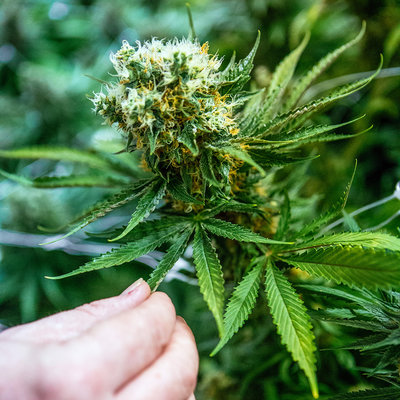
Used to be pot was just pot. Two dimes to the neighborhood hesher back in the day bought you a generic baggie of the giggle weed — that crispy, brown-green shake you’d smoke all afternoon without suffering anything other than the munchies.
These days, however, smokers arriving fresh to the scene best beware: One hit of the modern chronic and you’ll figure you’ve dropped a hit of window pane, the way it splits your cerebellum and sends you galloping into the wonky-doodle. The shit’s strong, boy.
Turns out, however, that psychoactive oomph — the heady and often paranoia-inducing qualities of bud’s THC content — is but one characteristic of any given strain, and not always its leading attribute.
Want heady and trippy? Go sativa-strong. Something mellow to take the edge off? Indica all the way. And that’s just the proverbial tip of the iceberg. We may be approaching the day when the individual smoker can be matched with a custom hybrid that fits like a velvet slipper.
“You will see more designer or grower-specific strains coming out,” says Adam Jacques, owner of Oregon Microgrowers Guild in Eugene. Jacques, a grower recently recognized as one of the “eight greatest minds in medical cannabis” at the Science of Cannabis Summit in Mesa, Arizona, says he’s excited to see new strains coming out as prohibitions on growing are lifted.
“Right now there is a bottleneck on strains, with everyone growing alike things,” Jacques says, “such as your Girl Scout Cookies, Blue Dream, Trainwreck, Jack Herer, tons of OG Kush. As people move forward, I see it being akin to the microbrewery movement we see right now — people creating their own strains through breeding and having a strain, or many, that is uniquely theirs.”
The chemical profile of cannabis is incredibly complex and difficult for the layman to untangle, but here goes: If it’s the THC in pot that gets you straight-up stoned, it’s the interconnected play of cannabinoids (CBD) and terpene compounds in the plant that appear to modify that high like a kind of flavoring, sometimes enhancing or magnifying it, at other times mellowing it.
In short, sativas have a high THC-to-CBD ratio; indicas are the reverse. The terpenes, then, add flavor, aroma and physiological affect to this basic dichotomy, breaking down into sub-categories such as pinene, linalool and myrcene, to name a few.
Here is how my friend Kermit, a top-notch grower and local weed-slinger, puts it: “The sativa psychoactive is very up in your head, gets you thinking, and they’re often the hybrids that are coming up with higher THC. The indicas put you to sleep, make you tired, really good for pain.”
Jacques says that it is through “phenotype hunting,” or the intricate and drawn-out breeding process, that he begins to discover new strains with specific attributes. He calls this search for new strains a “labor of love,” noting that, as labs gather more detailed information on DNA profiles of plants, phenotype hunting will grow increasingly streamlined and rapid.
“The knowledge of what cannabinoids and terpenes are dominant in a plant before you even grow it properly will absolutely allow us to ‘dial’ strains in to peoples’ specific wants and needs,” Jacques says.
Kermit gives a specific example. “That ‘couchlock’ feeling, there’s an associated profile for that,” he explains of that unable to move off the sofa sensation. “As an example, you can compare that to a microbrew that’s high in hops. That terpene that’s in the hops is the very same terpene that is in the cannabis that creates that ‘couchlock’ feeling. That’s just the first layer of the onion,” he adds.
Tune in next week when a EW staff member investigates (smokes) a range of strains, noting their particular effects on brain and body.